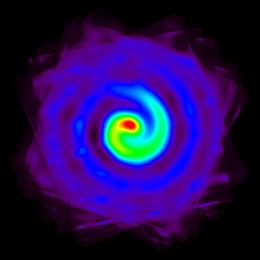Beautiful death-star could threaten Earth
3 March 2008
 |
"I
used to appreciate this spiral just for its beautiful form, but now I
can't help a twinge of feeling that it is uncannily like looking down a
rifle barrel," Dr Tuthill says. |
The Earth may be in the firing line when one of the sky's most beautiful objects explodes, according to University of Sydney astronomer Peter Tuthill.
Dr Tuthill discovered the elegant rotating pinwheel system, named WR104, eight years ago in the constellation Sagittarius. It includes a highly unstable star known as a Wolf-Rayet, widely regarded by astronomers as ticking bombs - the last stop in a star's life before a cataclysmic supernova explosion.
"When it finally explodes as a supernova, it could emit an intense beam of gamma rays coming our way", says Dr Tuthill, whose work is published in the latest edition of the Astrophysical Journal.
In the article Dr Tuthill reveals stunning new images of WR 104 taken with the Keck Telescope in Hawaii, showing a glowing plume of hot dust and gas flung out into a whirling spiral as the two stars at the centre of the system orbit one another every eight months.
But something odd about the images caught the attention of Dr Tuthill and his team: "Viewed from Earth, the rotating tail [see editor's note] appears to be laid out on the sky in an almost perfect spiral. It could only appear like that if we are looking nearly exactly down on the axis of the binary system."
Dr Tuthill and his team worry this box-seat view might put us in the firing line when the system finally explodes. "Sometimes, supernovae like the one that will one day destroy WR104, focus their energy into a narrow beam of very destructive gamma-ray radiation along the axis of the system. If such a `gamma-ray burst' happens, we really do not want Earth to be in the way." warns Dr Tuthill.
At only 8000 light years distance, WR104 is just down the road in galactic terms, only ¼ of the way to the centre of our Milky Way Galaxy. "Earlier research has suggested that a gamma-ray burst - if we are unfortunate enough to be caught in the beam - could be harmful to life on Earth out to these distances. Scientists have speculated that, eons ago, a gamma-ray burst from a distant star could explain mass extinctions seen in the fossil record," he said.
"I used to appreciate this spiral just for its beautiful form, but now I can't help a twinge of feeling that it is uncannily like looking down a rifle barrel."
But Dr Tuthill is not panicking just yet. "There are still plenty of uncertainties: the beam could pass harmlessly to the side if we are not exactly on the axis, and nobody is even sure if stars like WR104 are capable of producing a fully-fledged gamma-ray burst in the first place."
"We probably have hundreds of thousands of years before it blows, so we have plenty of time to come up with some answers."
Dr Tuthill has created awebsite, including spectacular time-lapse images of the system.
Notes to editor
The rotating tail
The tail is caused by strong winds from the two hot stars at the centre of the system. As co-discoverer Dr John Monnier from the University of Michigan explains, "The arc is a bit like a lawnsprinkler. Little flakes of red-hot carbon, just like the soot forming in a flame, are blown outwards with the winds. Then the orbital motion of the two stars entangles and twists the plume into the spiral shape that we see."
Gamma rays
Supernovae are believed to be behind massive bursts of gamma rays regularly detected from very faint and distant galaxies. Recent research suggests that these "gamma ray bursts" arise when exploding stars focus their energy into narrow beams aligned along the polar axis of the system, Dr Tuthill explains.
Contact: Kath Kenny
Phone: 02 9351 2261 or 0434 606 100
